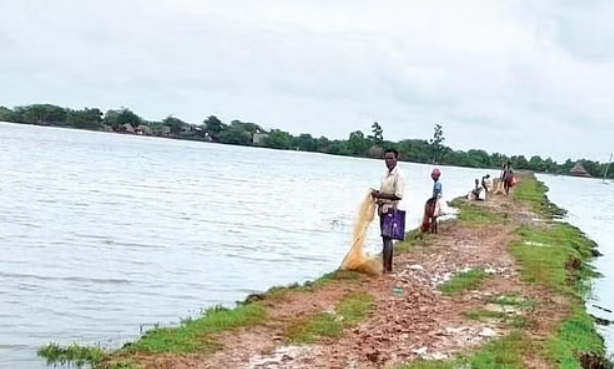Kendrapara: In a bid to protect the coastlines and strengthen the saline embankments, the state Water Resources department signed a memorandum of understanding (MoU) with the National Institute of Ocean Technology (NIOT) August 10 last year. A year has since passed but the state government is yet to take up any work on the project especially in Kendrapara district which has a long coastline.
The MoU aimed at the creation of climate change-resistant coastline and protection of saline embankments by 2026 was signed by Engineer-In-Chief Bijay Kumar Mishra and NIOT Director GA Ramdas in the presence of state Water Resources Minister Tukuni Sahu. The district which has a 744.37- km long saline coastline stretching from Dhamra sea mouth to Batighar is prone to natural calamities like floods, cyclonic storms and tsunami. There is an urgent need to protect the coastline which divides the hinterland from the sea. Water from the sea and rivers enter into as many as 455 villages in the district during natural calamities as the coastline is lying unprotected.
The Union Ministry of Earth Sciences has been sanctioning funds for the protection of coastlines. Moreover, an environmental protection law was formulated in 1986 for the protection of the environment in the area. The Coastal Regulation Zone (CRZ) has also been identified thrice in 1991, 2011, and 2019 and notifications have been issued in this regard.
However, despite all the measures in place, the coastlines of Kendrapara, Balasore, Bhadrak, Jagatsinghpur, Puri, and Ganjam districts are not secured. The Comptroller and Auditor General in his report from 2015-2020 which was submitted to the President had expressed serious concern over the increasing natural calamities in the district. The CAG had expressed displeasure that no serious concern is being shown towards the increasing frequency of natural calamities and said in its report that despite funds being spent, benefit is missing.
According to the CAG report, the coastlines have become industrial estates where industries have come up during these years.
Moreover, prawn gheries have mushroomed and human habitats have been spreading which are the other reasons behind the destruction of the coastlines. This has pushed the embankments and coastal environment under threat. The State Pollution Control Board (SPCB) handed over Rs 2.17 crore funds between 2013 and 2015 for the establishment of 19 laboratories to monitor the environment on the coastlines from Paradip to Dhamra. The SPCB is required to collect details on the changing environmental conditions on the coastlines through these laboratories.
However, it is yet to complete the work on these laboratories and consequently lagging behind in monitoring the air and water quality on the coastlines. It was claimed that 228 hectare of mangrove forest cover has been created under Rajnagar Forest Division and Puri Wildlife Division. However, only up to 35 per cent of mangrove forests were found in the area during a probe. Similarly, a geo-synthetic tube wall was constructed at an expense of Rs 33 crore at Pentha Beach in Kendrapara to check soil erosion on the coastline.
However, the wall has failed to serve any purpose as rocks and boulders have washed into the sea after tumbling out of the gabion box. The state government had even spent Rs 4.65 crore for the protection of the geo tube wall in 2018 and an additional `3.28 crore after it caught fire in August, 2019.






































